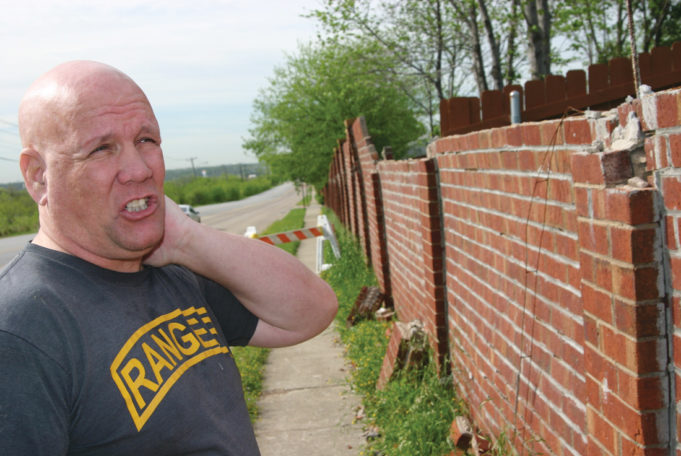Getting by on a fixed income means Jim Strachan doesn’t have much wiggle room when hit with an unexpected bill –– particularly a bill that could cost tens of thousands of dollars.
But if the City of Fort Worth has its way, that is precisely what he’ll be looking at.
Strachan and a dozen other homeowners have properties that butt up against Chapel Creek Boulevard, just north of I-30 in far west Fort Worth. The developer of the subdivision built a tall, long, noncontiguous screening wall with regular-sized red bricks in 1998. The wall stretches 2,000 feet, interrupted by several cross streets. Strachan (pronounced strawn) sees problems with the work. He doesn’t think the builder used enough rebar to strengthen the concrete footings. The concrete itself is suspect. Strachan plucks a piece from the wall behind his house and squeezes it between his fingers. It disintegrates.
The wall leans in places and is crumbling in others, particularly the part that’s on a slope. Gravity and the passing years haven’t been kind. Much of the collapsing section is located behind Strachan’s house.
City officials are targeting the entire wall for replacement and telling homeowners to come up with a plan for tearing down and rebuilding at their own cost. The wall is the responsibility of the developer at first but then passes on to the homeowners once the properties are sold.
“The city cannot use city funds on private property,” said City Councilman Zim Zimmerman, whose District 3 includes the Chapel Creek Addition where the wall stretches four blocks between Chapin Road and Meadow Gate Drive. “We understand that this is not an inexpensive issue. We have told them that we will go ahead and allow them to do brick columns and wood rather than the masonry that’s up there now. We’re talking to people like Habitat for Humanity to reclaim the brick. We’re doing everything we can to help.”
Strachan doesn’t see it that way. He sees city workers and elected officials passing the buck to unsuspecting residents. Strachan’s portion of the wall is about 100 feet long.
“The City of Fort Worth screwed up,” he said. “Now they want us, the residents, to fix it. I don’t see how the city expects that.”
Many of these tall, brick barriers can be found around town providing privacy and sound buffering for subdivisions. Zimmerman, who has served on the City Council since 2009, doesn’t recall one having to be torn down. Insurance typically covers walls damaged by vehicles or Mother Nature but not by natural failure.
“I’ve not seen anything of this magnitude yet,” Zimmerman said.
About a year ago, Strachan contacted five different masonry contractors for estimates to fix the wall.
“They wouldn’t touch it,” he said.
Most of the contractors said the wall needed to be torn down and replaced. One contractor wanted $10,000 just to tear it down and haul off the debris. Strachan had found someone on Craigslist to try to fix the wall for $1,500, but the repairs didn’t hold. The developer of the subdivision has since retired and moved out of state.
“They did everything half-ass and as cheap as they could,” Strachan said. “This wall was built before any of the houses were built. My house was built in 2001, and this wall was already here. The city put it in our laps. The city allowed this wall to be built.”
Zimmerman said the statute of limitations has surely passed.
“Obviously, the developer is long gone, and even if he was around, he would deny anything was done wrong with it,” Zimmerman said.
The Code Compliance Department sent letters to property owners last October after someone who walks a dog on the sidewalk regularly complained about loose bricks falling into the path. The fence, wrote the Code Compliance Department, needed fixing because it “presents a hazard to the property owners, residents, and those walking along Chapel Creek.” Failure to comply “may result in a fine of up to $2,000 for each day the property remains in violation.”
Notices of violations were sent on February 19. Code Compliance officers gave the homeowners until February 29 to fix the wall but later delayed the deadline.
Another letter on April 4 told residents to develop a detailed plan for repairing or replacing the wall within 180 days. The wall sits just a few inches from the sidewalk that stretches along Chapel Creek Boulevard. The city’s help will be needed: Taking down the wall will require blocking the sidewalk and possibly a lane or two of traffic.
Strachan has tried to rally his neighbors to fight city hall but has found it difficult to align them since about half the homes are rental properties. Gary Hogan, president of the Chapel Creek Neighborhood Association, said he has been looking into the situation for eight years.
Here’s how the problem evolved, according to Hogan: Someone called the city in 1998 and complained that the contractor was using mortar rather than concrete on the footings for the wall. A city inspector issued a cease and desist order after discovering the contractor had not been issued a building permit. Eventually, the city issued a permit, the contractor finished the job, and the city approved it. By 2008, the wall was leaning and starting to crumble in places, particularly where the ground slopes. Hogan tracked down the contractor, who said he could build walls with 10-year-warranties or 20-year warranties. Or he could build the Great Wall of China that will last for ages. The developer asked for the cheapest version with a 10-year warranty, Hogan said, and he got what he paid for.
In addition to questionable concrete, the contractor used un-galvanized and oversized H-wire that rusted and grew weak in the mortar, Hogan said.
Three different appraisers looked at the wall in 2008 and said it needed to be torn down and rebuilt. Estimates back then were $10,000 to $15,000 per 50 feet of wall, Hogan said. An estimate today might be closer to $20,000 per 50 feet. Most property owners have between 50 and 100 feet of wall on their property. Since Strachan’s backyard is 100 feet long, he might need $40,000 to fix his portion.
“Nobody can afford to build that masonry wall,” Hogan said.
City officials might relax the standard for a masonry wall in that subdivision and allow for cedar fencing in between brick columns. But they want a common design. That means getting 13 homeowners to agree to a design, come up with the money at the same time, agree to a contractor, and get the job done.
“This is like herding cats, trying to get 13 property owners to come to a meeting,” Hogan said. “That’s where I am right now.”
Time is ticking. That 180-day ultimatum will be up on October 4. If the neighbors don’t act, the city can tear down the wall, rebuild it, and charge the homeowners by putting liens on their houses.
“These people are in a terrible predicament,” Hogan said. “They were built a bad wall. But what are you going to do now, 18 years later?”
It’s a question being asked by more and more cities as their screening walls begin to falter over time. Many cities deem the walls as private property, passing maintenance responsibilities to homeowners. But some, like Plano, are becoming more proactive.
“We went to our City Council about a year ago and said none of our homeowners can afford to replace a wall of this sort,” Public Works Director Gerald Cosgrove said. “We decided the city, if the homeowners agreed, would take them over.”
The new rule in Plano applies to screening walls like the one on Chapel Creek Boulevard in West Fort, built by a developer in a neighborhood without a homeowner association. Walls inside neighborhoods governed by homeowner associations are the responsibility of the association, Cosgrove said.
“To replace these walls can be very expensive,” he said. “We typically pay more than $300 a linear foot. A lot of the money is spent on the underground foundation.”












There are plenty of areas in Fort Worth where fences are required by code. When one buys a house, it’s part of the buyer’s due-diligence to ascertain whether fences on the property need repairs and who is responsible. Presumably, when Strachan purchased his property, he paid less than full value based on anticipated costs of repairing the fence, same as if the house needed a new roof. In my opinion, owners should bear the cost of repairs to their fences.
That said, there are plenty of places in Fort Worth where masonry fences are crumbling or leaning. A masonry fence must have a massive foundation to counteract natural forces. An extreme example is the masonry fence that runs several blocks along Jacksboro Highway north of its intersection with University Drive (and W. Northside Drive). The entire fence tilts toward the highway because it is bearing the weight of a virtual mountain. Even in subdivisions where the City allows masonry posts with wood panels, masonry posts often tilt a few years after construction. In my opinion, the City should allow wood fences mounted on galvanized posts set in concrete. These fences are cheaper to build and are easily repairable by the average homeowner. And they are no less attractive than masonry fences, given that the later will typically end up looking like Strachan’s fence with passage of time.
My name is Todd Sternfeld owner of Superior Concrete Products
Our precast concrete screening walls meet the criteria of a masonry fence at a less price point per foot. We have been in business for over 30 years. Best of all we are located in Euless and our factory is in Cleburne.
We do work all over the United States.
Let me know if we can be of any assistance.
Regards
Todd
Your wall, your responsibiity.